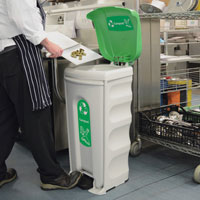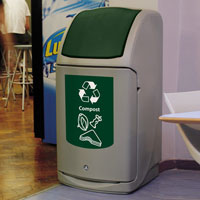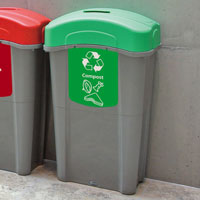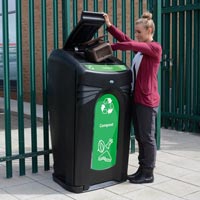How well does your school grade for food waste reduction? In 2015, the EPA announced its goal to reduce food waste by 50 per cent by the year 2030.
A substantial amount of food waste occurs throughout schools, colleges and universities in the United States. According to Recycling Works, the average college student throws away a significant 142 pounds of food every year. Reducing food waste at your college or university can positively influence the sustainability, ecology and economy of your institution. We aim to help you to educate students and faculty members about the volume of food waste in your school and how you can work together to reduce waste.

Follow our food-waste reduction tips to ensure your college is feeding nutritious food to student’s minds, not the cafeteria trash can:
Create a tray-less dining policy
The way that your dining hall is operated can impact the levels of food waste produced. Many higher education cafeterias use the traditional ‘buffet-style’ service. To accommodate for this service style, college dining-hall managers will often over-estimate how much food will be consumed, resulting in a surplus of food being served.
Tray-less cafeterias are becoming a national trend across college dining halls. Research by Western Michigan University found that implementing a tray-less dining policy reduced post-consumer food waste by up to 30 per cent.
Removing trays from college dining halls will limit the amount of food students take causing them to think more consciously about their food choices. In turn, this will reduce the level of waste generated by students.
Increase awareness among students
Educating students on food waste reduction can help them to understand the amount of food waste they generate and how they can solicit ideas for change. There are a variety of ways that you can increase awareness among students and encourage them to positively change their food consumption patterns. One way this can be done is by reinforcing your food waste recycling message through student promotional materials such as the campus newspaper, radio or posters.
Donate surplus food
The Richard B. Russell National School Lunch Act request schools make substantial efforts to recover or donate left-over foods. Untouched or unopened excess food can be donated to non-profit organizations such as eligible local food banks, homeless shelters or charitable organizations.
Harvard University Dining Services salvage and donate left-over food from their campus dining halls to Food for Free, a non-profit organization helping fight food-insecurity. During the 2014-15 school year, food donations from Harvard University generated more than 45,000 meals.
Implement a composting system
To make sure any left-over food is diverted from trash cans, we recommend using dedicated organic waste and compost bins. Placing composting receptacles in campus dining halls and other areas where food waste is often generated will motivate students to be responsible for correctly disposing of their food waste.
After conducting a waste audit, University of Minnesota, Morris found that they could save money by diverting food waste from landfill.
We offer a wide range of organic waste containers to help you reach your food waste goals:
|
|
|
|
Recycle Bottles
The recycling possibilities in higher education are endless. As well as effectively diverting food waste from landfill, you could also look at enhancing your school’s recycling rates for plastic bottles. A University based study found that placing plastic bottle recycling bins in areas where drinks are consumed, such as classrooms, substantially increased the recycling rate.
Create a co-ordinated recycling station in campus dining halls by siting plastic bottle recycling bins next to compost containers to encourage students to recycle used drinks bottles. This will increase the number of plastic bottles recycled within college grounds and will enforce your schools environmental message.








